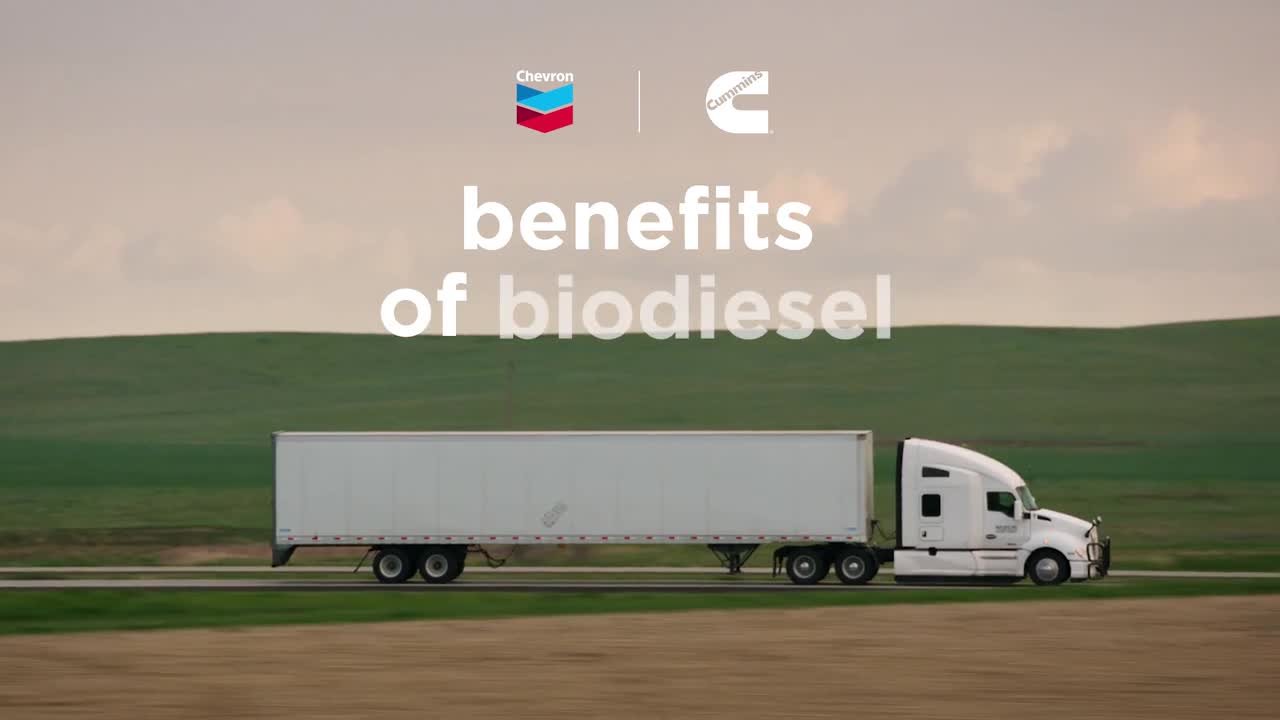Q & A: The benefits of biodiesel and how it can reduce lifecycle carbon emissions today
Article originally authored and published by Chevron Renewable Energy Group
By Cummins Inc., Global Power Technology Leader

The world population has grown to nearly 8 billion people and is anticipated to reach 9 billion people by 2040. With such growth, global energy demand is expected to increase by 15% in the coming decades. 1
That means all available fuel solutions will be necessary to meet the increased demand for affordable energy. Biodiesel is one of those solutions.
Today, more companies are focusing on the environment and demonstrating scalable, lower carbon-intensity business practices. They are looking at how lower carbon fuel solutions can help their companies reach lifecycle carbon emissions targets and also use them as a way to potentially gain a competitive edge in the marketplace.
As the largest contributor to greenhouse gas emissions in the United States, commercial transportation is a critical segment in this paradigm shift. 2
Logistics companies and shippers find themselves in the spotlight, tasked with leading the way in reducing greenhouse gas emissions. 3
Dave Slade
Chief Scientist, Chevron Renewable Energy Group
Q: Biodiesel is available as a lower carbon fuel option for Cummins diesel products, but it's really great to see even further commitment to renewable fuels for future Cummins products. What does that mean for biodiesel use in diesel engines today?
A [Dave Slade]: Biodiesel is commonly seen as having kind of a limited-blend opportunity to play.
Chevron Renewable Energy Group has been proving that biodiesel can be blended at almost any level with both traditional petroleum diesel and renewable diesel.
We are grateful that Cummins is willing to go along with us on this journey and look into the possibility of getting more biodiesel out into fleets today.
I think that companies often consider long-term options, but biodiesel is really the one option that’s available today in quantities that haven’t yet been exploited.
So, we consider 20% biodiesel blended into petroleum diesel, which is commonly known as B20, to be a level that many people are comfortable with today.
Cummins is already there with recommending B20 in their products, which is great, but we’re looking to find ways – for those in areas where biodiesel is available – to use more than 20%.
We don't see 20% as a blend wall, in the way that is sometimes associated with ethanol having a blend wall. We think this is really just a preferential limit based on historical fuel quality. What's really been great in North America is that we've seen the modern quality of biodiesel actually surpass anything that could have been imaged 15 years ago.
Ivan Iazdi
Engine Strategy and Business Development Director, Cummins Inc.
Q: How does Cummins see the benefit of using biodiesel in your engines and what role does this fuel play in your Destination Zero strategy?
A [Ivan Iazdi]: Cummins' Destination Zero strategy is all about decarbonization. Cummins business, as a whole on the engine side, is introducing new engines to help accelerate carbon reduction.
Internal combustion engine, or ICE technologies, are an important transitory step for the trucking industry.
Cummins will be launching our fuel-agnostic engines and in the coming years, will support Destination Zero to deliver a product to help customers reduce emissions as part of the fuel-agnostic platforms. We have kept a focus on advanced diesel solutions and each of these diesel engines benefit our acceleration to lower emissions by continuing to meet stringent emissions regulations and providing a familiar technology for customers.
The reduction of emissions from these engines is amplified with the use of biodiesel which will be available on future platforms and has actually been available with our on-highway products dating back to 2007.
We do not see decarbonization as a “light switch” event, we need to take advantage of the opportunities that are available now.
Watch the full podcast below:


- The energy transition needs solutions, scale and speed, interview with Mike Wirth https://www.chevron.com/sustainability/climate
- https://www.epa.gov/greenvehicles/fast-facts-transportation-greenhouse-gas-emissions
- https://www.epa.gov/ghgemissions/sources-greenhouse-gas-emissions#:~:text=Transportation%20(28%25%20of%202021%20greenhouse,ships%2C%20trains%2C%20and%20planes.
Author Profiles

Cummins Inc., Global Power Technology Leader
Cummins Inc., a global power solutions leader, comprises five business segments - Components, Engine, Distribution, Power Systems, and Accelera by Cummins - supported by its global manufacturing and extensive service and support network, skilled workforce and vast technological expertise. Cummins is committed to its Destination Zero strategy - the company's commitment to sustainability and helping its customers successfully navigate the energy transition with its broad portfolio of products. Cummins has approximately 69,900 employees and earned $3.9 billion on sales of $34.1 billion in 2024. See how Cummins is leading the world toward a future of smarter, cleaner power at www.cummins.com.
Temas relacionados
Related Tags